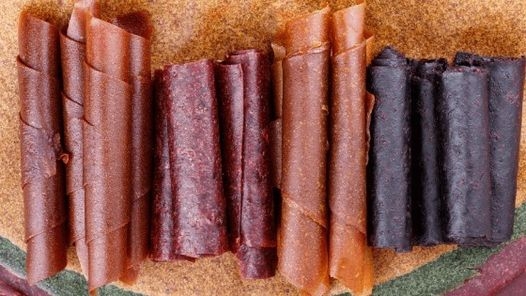
We are all likely familiar with fruit leather, sometimes called fruit roll ups. They are a wonderful snack or addition to a bag lunch. Delicious and chewy, they are a satisfying treat. Made by spreading pureéd fruit or vegetables on a flat surface and drying until it has leather - like texture, from which it gets its name.
If you make your own leathers it has many advantages. You can use little or no sugar, as desired. You can use leftover fruit pulp from making jelly or take a thin batch of jam and mix it with thicker fruit like applesauce. You can use vegetables! You can make unsweetened fruit leather with measured amounts of fruit for diabetic individuals for a healthy snack, and you can make it with fresh, frozen, or drained canned fruit as desired. What could be more versatile than that?
Preparing the fruit:
To make fresh fruit leather select ripe or slightly overripe fruit. Wash, peel as needed, and remove pits, seeds, and stems. Cut larger fruit into chunks. It will take about 2 cups of cut up fruit to make each 13” x 15” fruit leather. Pureé or run through a food mill until smooth. To prevent darkening you can add 2 teaspoons of lemon juice or 1/8 teaspoon ascorbic acid to each 2 cups of lighter colored fruit. Add sweetener if desired, ¼ to ½ cup of sugar, honey, or corn syrup per 2 cups of pureé.
If you use canned fruit, drain but save the liquid. If too thick you can add some of the reserved liquid. If frozen, thaw and proceed similarly. With either, treat for darkening or sweeten as desired as for fresh fruit. Always remember that dehydrating condenses the flavors.
To any of the above you can add applesauce to both sweeten and give it a smoother and more pliable finished product. Of course, applesauce makes a wonderful fruit leather all by itself.
If desired you can flavor your fruit leather with a bit of spice such as cinnamon or ginger. Start with 1/8 teaspoon per 2 cups purée. Alternately, you can flavor with 1/8 to ¼ teaspoon of vanilla or almond extracts, lemon, lime, or orange juice or zest.
You can also create unique fruit rolls by garnishing with shredded coconut, sesame seeds, chopped nuts or other seeds or chopped dry fruit, before dehydrating.
Vegetable Leathers:
You can make vegetable leather snacks as well! Using puréed cooked vegetables, proceed as for fruit leathers.
Make a mixed vegetable leather by cooking 2 cups cored cut up tomatoes, 1 small chopped onion, ¼ cup chopped celery and salt to taste over low heat for 15 to 20 minutes. Purée and cook more until thickened. Dry as for fruit leather.
You can do the same just using tomatoes. Or steam carrots to purée and dry plain, or mixed with applesauce.
Or try pumpkin leather using 2 cups canned or cooked puréed pumpkin, adding ½ cup honey and a dash of cinnamon, nutmeg and cloves.
Dehydrating:
Leathers can be dried in the oven, a dehydrator, or simply out in the sun.
To dry in the oven or sun, use a 13” x 15” baking sheet with edges. Line the pan smoothly with plastic wrap. Do NOT use wax paper or aluminum foil as they can tear and remain stuck in pieces to the finished product.
If you are using a dehydrator you can purchase special plastic sheets or line the trays with plastic wrap. I have used parchment paper, but you have to be careful it doesn't tear when you remove it.
Pour the prepared fruit onto the covered surface and spread out about 1/8 inch thick, leaving clear space all around the edges. You can make one large sheet per pan or several smaller ones. Larger ones take longer to dry.
In the oven, dry at about 140º. 135º is recommended in a dehydrator with a temperature gauge. It takes about 1 to 2 days in the sun, up to 18 hours in the oven, or 6 to 8 hours in a dehydrator, all depending on the sheet's size and thickness. Test for doneness by touching the center of the leather, as they dry from the edges in.
When your touch does not leave an indent and it is only slightly sticky, your leather is done. Peel it from the plastic while still warm and roll. If very sticky you can dust with powdered sugar before rolling. Let cool, then wrap in plastic wrap to store. Alternately you can cut it into snack size squares, rectangles, or even cookie cutter shapes.
Fruit or vegetable leathers will keep, wrapped, up to one month at room temperature. For longer storage, up to one year, wrap tightly in plastic and freeze.
Of course, if your family likes them as ours does, you will never have a need for long-term storage!
Questions about food preservation? Contact the Master Food Preserver Program through the Humboldt County Cooperative Extension Office for information: 707) 445-7431, or online
References:
National Center for Home Food Preservation https://nchfp.uga.edu
So Easy to Preserve (5th edition, Cooperative Extension, University of Georgia)
Excalibur – The Complete guide to Food Dehydration